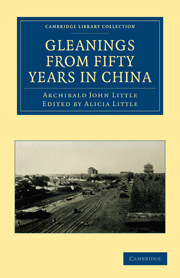Book contents
- Frontmatter
- FOREWORD
- EDITORIAL NOTE
- Contents
- PART I TRADE AND POLITICS
- WESTERN CHINA: ITS PRODUCTS AND TRADE
- BRITISH TRADE WITH CHINA
- EX ORIENTE LUX
- TWO CITIES: LONDON AND PEKING
- THE VALUE OF TIBET TO ENGLAND
- THE PARTITION OF CHINA
- HOW TO REGISTER YOUR TRADE MARK
- PART II TRAVEL
- PART III DRAMA AND LEGEND
- PART IV RELIGION AND PHILOSOPHY
- INDEX
- Plate section
TWO CITIES: LONDON AND PEKING
Published online by Cambridge University Press: 10 November 2010
- Frontmatter
- FOREWORD
- EDITORIAL NOTE
- Contents
- PART I TRADE AND POLITICS
- WESTERN CHINA: ITS PRODUCTS AND TRADE
- BRITISH TRADE WITH CHINA
- EX ORIENTE LUX
- TWO CITIES: LONDON AND PEKING
- THE VALUE OF TIBET TO ENGLAND
- THE PARTITION OF CHINA
- HOW TO REGISTER YOUR TRADE MARK
- PART II TRAVEL
- PART III DRAMA AND LEGEND
- PART IV RELIGION AND PHILOSOPHY
- INDEX
- Plate section
Summary
Two cities in the modern world claim pre-eminence as the capitals of the two most populous empires in existence—Britain and China. Both claim further attention as the respective centres of two of the leading types of human civilisation, as well as of the great political interests that have in them their foci. London, the metropolis of the English-speaking world in the extreme West, with Peking, the metropolis and Mecca of the Indo-Chinese nations in the Far East: one at either extremity of the great Eurasian continent, a counterpoise, as it were, to each other, they stand forth like sentinels at the two ends of the ancient world. These two beacons of light and learning, situated on the margin of the once impenetrable bounds of the watery setting in the midst of which terra firma stood forth, now both face that New World of the existence of which their respective founders were naturally ignorant, but which bids fair in the not far distant future to reshift the centre of gravity to a new continent. In the meantime a comparison of the points of analogy and of antithesis which these two great metropoles offer to the unprejudiced observer, visiting them as they now exist at this latter end of the Nineteenth Century, offers much matter for reflection, from which I purpose to select a few of the more salient points.
- Type
- Chapter
- Information
- Gleanings from Fifty Years in China , pp. 74 - 91Publisher: Cambridge University PressPrint publication year: 2010First published in: 1910

